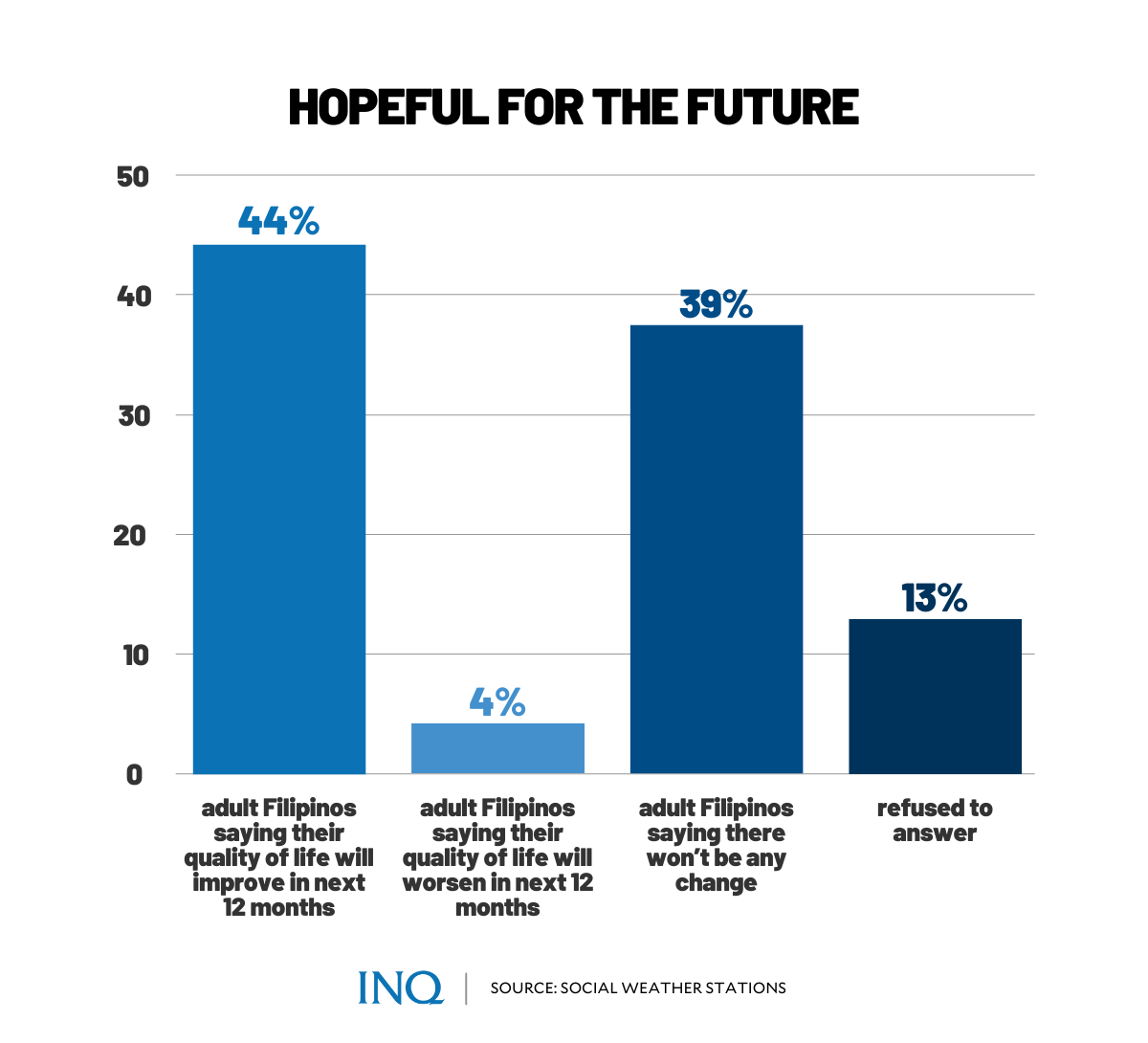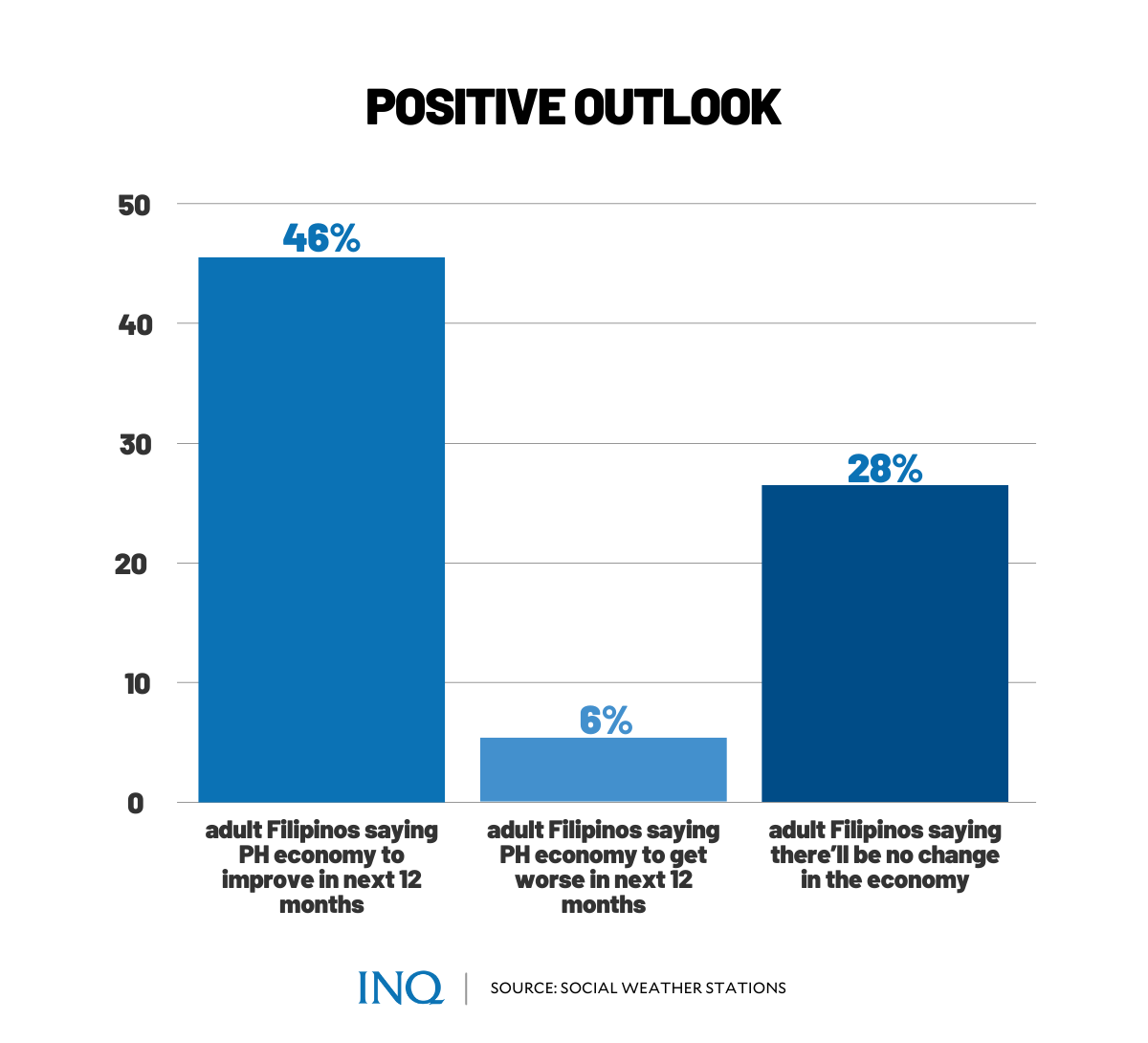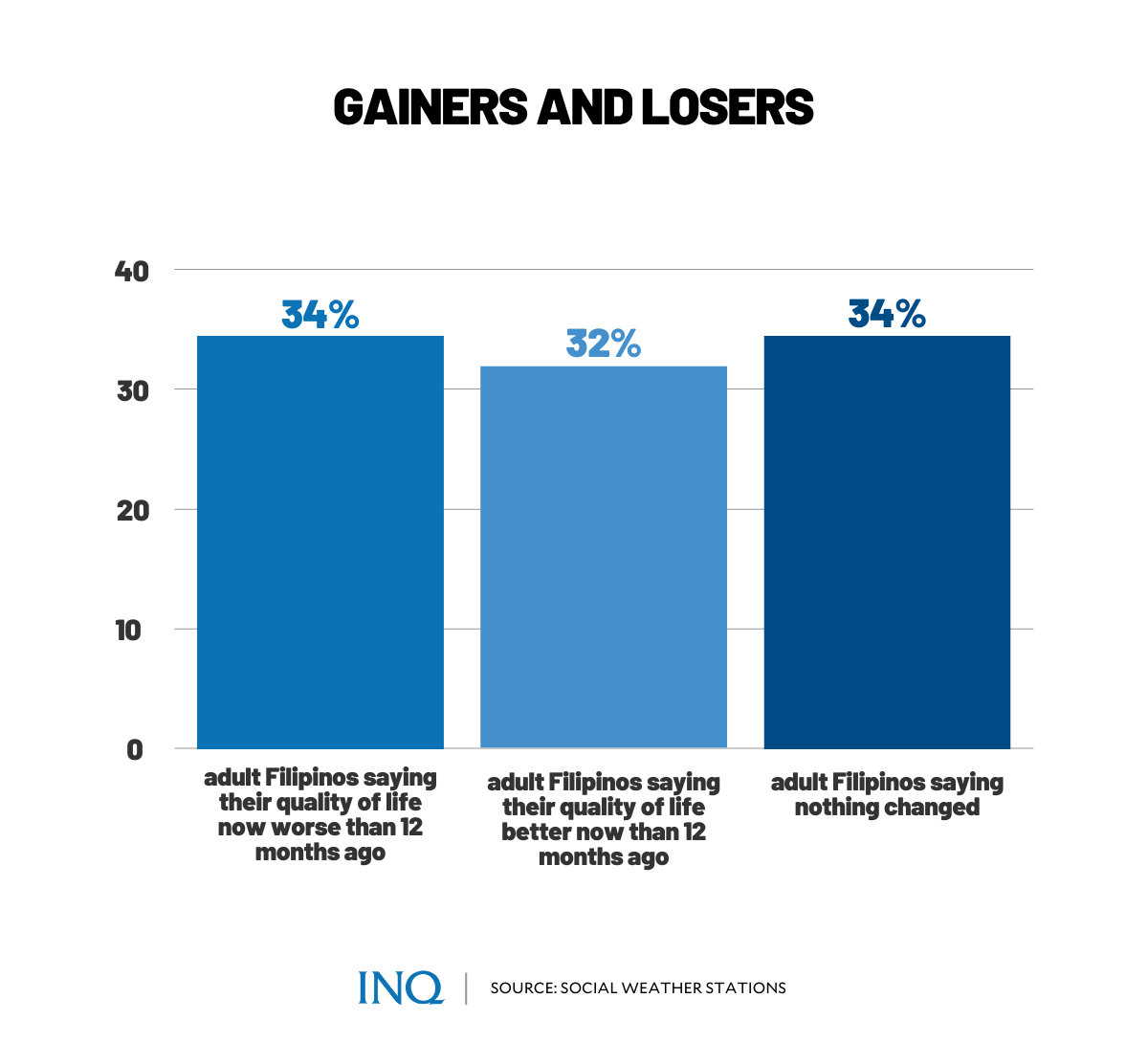Life will be better? Surveys show optimism growing
MANILA, Philippines—Two recent national surveys of the Social Weather Stations (SWS) revealed that more Filipinos believe that the country’s economy and their quality of life will improve in the following months compared to those who expressed the exact opposite views.
According to the latest SWS poll released on Sunday (July 10), 46 percent of adult Filipinos expressed belief that the economy will improve in the next 12 months.
This was despite recent inflation figures released by the Philippine Statistics Authority (PSA), which showed that the country’s headline inflation rate for June 2022 was 6.1 percent—a three-year high since November 2018’s 6.1 percent and October 2018’s 6.9 percent.
On June 24, the SWS also released a survey, which showed that 44 percent of adult Filipinos believe that their quality of life will improve in the next 12 months.
Although the two surveys were published weeks apart, the polling firm said findings from the latest survey are directly related to the June survey.
Article continues after this advertisementIn this article, INQUIRER.net will dive into the findings presented in those two SWS surveys, including the correlation between the two polls, and how certain factors, such as socioeconomic and educational background, could have played a role in the survey results.
Article continues after this advertisementEconomic optimists, pessimists
The July survey, conducted between April 19 and 27 using face-to-face interviews of 1,440 Filipino adults nationwide, found that 46 percent of adult Filipinos believe that the Philippine economy will improve within the next 12 months.
These individuals were termed by the polling firm as “economic optimists.”
On the other hand, 6 percent of the survey respondents were found to be “economic pessimists,” who said they believed that the country’s economy will worsen in the following months.
Meanwhile, 28 percent of Filipino adults were categorized as “neutral” or those who said the country’s economy will remain the same as months pass by.
The figures led to a net optimism score of +40, which was classified by SWS as excellent.
“The latest Net Economic Optimism score is 4 points below the excellent +44 in December 2021. It used to be mediocre -9 in July 2020, mediocre -5 in September 2020, and high +24 in November 2020, during the first year of the COVID-19 pandemic,” SWS noted.
Although the survey showed that the majority of the respondents hoped for a better economic situation in the country, economists warned the public of another round of effects of the country’s rising inflation rate.
According to Nicholas Mapa, ING Manila’s senior economist, the second round of inflation will hit harder, as firms impose a new round of price increases on many goods and services that are part of the Consumer Price Index (CPI) basket.
“What we’ve been through in the past few months is the first round of effects so I guess this is ‘the right hook to your chin,” said Mapa in an interview over One News PH.
“In the next few months, we’ll be dealing with the second-round effects that have just been very much apparent…The second-round effects are gonna bite us. In the second half of the year, I’m starting to see more items in the CPI basket become infected with high inflation as firms have no choice but to increase their prices,” Mapa added.
National Statistician Dennis Mapa explained that the increase in last month’s inflation rate can be attributed to higher food, fuel, and transportation costs, as well as costlier alcoholic beverages and cigarettes.
Moreover, PSA stated that the purchasing power of the peso eroded to 87 centavos in June—the lowest to date—since the CPI was rebased to the year 2018. Mapa said this meant that fewer goods can be bought now compared to every P1 four years ago.
READ: High inflation: Your P1 is now worth only 87 centavos
Improved quality of life soon?
The survey released last month, although also conducted between April 19 and 27 using face-to-face interviews of 1,440 adults nationwide, found 44 percent of Filipinos saying their quality of life will improve in the next 12 months.
These individuals were termed by SWS as “optimists”.
Only 4 percent were marked as “pessimists” after answering that their quality of life will worsen in the following months. At least 39 percent said their quality of life will not change even after a year.
At least 13 percent did not answer the question, “In your opinion, what will be the quality of your life in the coming 12 months? Would you say that your quality of life WILL BE BETTER, SAME, or WILL BE WORSE?”
The figures resulted in a net personal optimism of +39 classified by SWS as very high (+30 to +39).
Last May, the country’s unemployment rate rose to 6 percent, which was higher compared to 5.7 percent in April.
This translated to 2.93 million unemployed individuals in May.
READ: Unemployment rate up to 6% in May
Link between economic and personal optimism
Although economic optimism is different from personal optimism, SWS found that net economic optimism is higher among personal optimists (+63) compared to those who said “no change” (+31), and personal pessimists (-35).
“Compared to December 2021, Net Economic Optimism stayed excellent among Personal Optimists, although down by 6 points from +69 to +63. It rose from high to very high among those who said ‘No Change,’ up by 5 points from +26 to +31,” the polling firm said.
“It fell from very low to extremely low among Personal Pessimists, down by 13 points from -22 to -35,” it added.
Views based on educational attainment
The two different surveys likewise highlighted that net economic optimism and net personal optimism varied according to educational attainment.
Net economic optimism, according to SWS, was highest among those who either finished junior high school, had some vocational schooling, had some senior high school, finished senior high school, completed vocational school, or attended some college (or junior high school graduates) at +43—classified as excellent.
Meanwhile, net economic optimism points among other adult Filipinos based on their highest grade completed were as follows:
- those who either had no formal education or some elementary education (or non-elementary graduates) +39—very high
- those who either finished elementary or had some high school education (or elementary graduates): +37—very high
- those who either graduated from college or took post-graduate studies (or college graduates): +34—very high
The survey released in June showed entirely different results.
Out of the total survey respondents, net personal optimism was highest among those who either graduated from college or took post-graduate studies—at +50, classified as excellent by SWS.
Net personal optimism among other groups based on the highest grade accomplished was:
- those who either had no formal education or some elementary education: +33—very high
- those who either finished elementary or had some high school education: +30—very high
- those who either finished junior high school, had some vocational schooling, had some senior high school, finished senior high school, completed vocational school, or attended some college: +45—excellent
Based on data from the PSA, out of the estimated 2,927,000 unemployed individuals in May this year, at least 24.4 percent were college graduates while 12.6 percent were college undergraduates.
Most of the unemployed persons for that month were either junior high school undergraduates (8.7 percent) or graduates (29.5 percent).
At least 1 percent of senior high school undergraduates were among the unemployed while 6.1 percent were high school graduates.
Around 5.7 percent represents those who were unemployed who had post-secondary education.
Only 0.9 percent had no formal education, and 11.1 percent finished or had some elementary education.
‘Gainers’ more optimist than ‘losers’
The SWS also found that there were more people who believe that their quality of life was worse than 12 months before. These people were called “losers” by the polling firm.
At least 34 percent said it was the same.
Net economic optimism, the surveys showed, was higher among the gainers (+51) than among the unchanged (+33) and losers (+37).
Non-poor, non-hungry showed more optimism
Individuals, who identified themselves as “non-poor” and are among the “non-hungry” families, are also most likely to display economic and personal optimism, according to the survey.
A separate and much earlier survey conducted by SWS showed that 43 percent of Filipino families rated themselves as poor, 34 percent rated themselves as borderline pool, and 23 percent rated themselves as not poor.
READ: 10.9M Filipino families felt ‘poor’ in Q1 of 2022 – SWS survey
The net economic optimism was +54 among Filipino adults who are part of families that consider themselves as not poor.
On the other hand, among those who belong to families who consider themselves as borderline poor and among those who belong to families who consider themselves poor, the net economic optimism was +39 and +32.
Another SWS survey also found that 12.2 percent of Filipino families, or an estimated 3.1 million, experienced involuntary hunger—being hungry and not having anything to eat—at least once in the past three months.
READ: 3.1 million Filipino families experienced hunger in Q1 of 2022 – SWS
The net personal optimism score was highest among adults who belong to families that did not experience hunger months back (+41).
Net personal optimism among those who belong to families that experienced hunger in general, those who belong to families who experienced moderate hunger, and those who belong to families who experienced severe hunger were +30, +31, and +28 respectively.
“Moderate Hunger refers to those who experienced hunger ‘Only Once’ or ‘A Few Times’ in the last three months. Meanwhile, Severe Hunger refers to those who experienced it ‘Often’ or ‘Always’ in the last three months,” said SWS.



